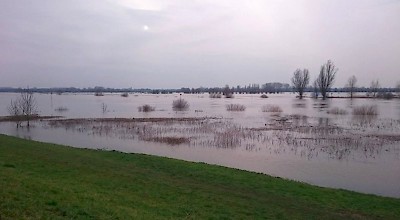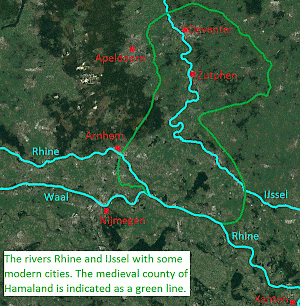Chamavi
Q859987Chamavi: ancient Germanic tribe on the northern edge of the Roman Empire.
Homeland: Hamaland?

Like all Germanic tribes in northwestern Europe, the Chamavi are, as ethnonym, best known from Greek and Latin sources. The authors mention the Chamavi on various places. The first reference is by Tacitus, who places their original country somewhere north of the Lower Rhine.
From his story,note we can deduce several things. To start with, the Chamavi were no longer in political control of this land by 58 CE. In the second place, the fields in this area were used by Roman soldiers, which suggests that a Roman base such as Nijmegen or Xanten must have been in the vicinity.note We also learn that the land could be reached from the land of the Ampsivarii and the Tubanti, while the Usipetes (a wandering tribe) had also once lived over there.
All this points to an area in the east of the Netherlands, where we later find an Early Medieval county named Hamaland. That word can indeed be interpreted as “land of the Chamavi” and is, essentially, the area of the river IJssel. This identification is consistent with Tacitus’ remark that the Chamavi had, in his own age, occupied land of the Bructeri, which was directly to the southeast of Hamaland.note Perhaps some Chamavi migrated even further, to the area of the Upper Elbe and Vistula, because Καμαουί are mentioned here by Ptolemy.note They may be a different tribe, though, which happened to have a similar name.

It should be stressed that the similarity between Chamavi and Hamaland is not sufficient proof. A slightly more western location – west of modern Arnhem – is also possible, although Tacitus’ remark that Frisian settlers reached the land of the Chamavi “across the lakes” (i.e., Lake Flevo) may contradict this.note However this may be, we cannot assume that all Chamavi had really evacuated their homeland and migrated to the east, because they were still recognizable in Late Antiquity, as we will see below, and were by then certainly living in Hamaland.
Economic and religious life
As Tacitus suggests, the land of the Chamavi was controlled by the Roman army. It seems that the native Germans were not just shepherds: farms have been excavated and prove that the peasants living north of the Rhine worked bog iron. (Iron used to be produced along the IJssel until the nineteenth century.) It would appear that the German peasants had acquired their knowledge from the Romans, who must have been among their greatest customers.
As a result, there was some economic growth in the eastern part of the Netherlands in the third century CE. This is veryremarkable because in other parts of the region, this was a period of decline. The age of prosperity came to an end when Roman control of the Rhineland came to an end in the early fifth century.
Two inscriptions refer to the matres of the Chamavi.note Remarkably, both have been found in the same area near Juliacum (modern Jülich in Germany): one in Altdorf, five kilometers to the south of the Roman town, and the other in Pier, seven kilometers to the southeast. There may have been some kind of settlement of deported Chamavian POWs, who continued to worship their ancestral gods. Alternatively, it may be a local triad with a name resembling that of the northern tribe.
Fourth Century
An anonymous orator mentions Chamavian and Frisian invaders who were resettled as farmers after a victory, achieved by Constantius I Chlorus in the summer of 293, in the area between the Lower Scheldt and estuary of the Rhine.note This is evidence that the Chamavi were still living somewhere in the Lower Rhineland and had not migrated to the east.
It also fits the reference by Ammianus Marcellinus that the Chamavi could, together with the Salian Franks, proceed along the Meuse to invade Toxandria.note Both tribes were defeated by the army of the future emperor Julian the Apostate, who ordered the Chamavi to return to their homeland and bring their harvests to Roman forts on the banks of the Meuse.note This is only possible if the Chamavi lived, at this moment, in Hamaland. Zosimus adds that Julian added Franks, Chamavi, and people from the island of the Batavi to his army.note
Eunapius informs us that on this occasion, the leader of the Chamavi was a king named Nebisgast. The Greek historian also mentions a discussion between the Roman and Chamavian commanders that took place on the banks of a river, which can only be the wide Rhine because Julian could stand on a ship and remain outside the reach of enemy missiles.note
Several other fourth-century sources mention the Chamavi together with but independent from the Franks. One of them is Ausonius, who mentions the Chamavi, Franks, and Germans in one breath.note The editor of the Peutinger Map also mentions Chamavi qui et Franci. Sulpicius Alexander describes how the Roman commander Arbogast in the early 390s successfully attacked two Frankish kinglets, Sunno and Marcomer, who ruled in the land of the Bructeri and Chamavi on the banks of the Rhine.note Following Arbogast’s advance, we must again conclude that by the end of the fourth century, the Chamavi were living in Hamaland. In the fifth century, they must have become integrated in the Frankish federation.
Fifth century
One final, intriguing reference to the Chamavi can be found in the Notitia Dignitatum, which records an Eleventh Cohort of Chamavi serving at a place called Peamus under the dux of the Thebais, just like a First Ala of Franks.note We may perhaps speculate that this Chamavian unit was added to the Roman army by Julian, who took it with him when he went to the east. One of his successors may have transferred this unit to Egypt, where local recruits will have replaced the original soldiers. Alternatively, these two units may have been transferred to Egypt during the reign of Probus.note
Literature
Henk van der Velde, Wonen in een grensgebied. Een langetermijngeschiedenis van het Oost-Nederlandse cultuurlandschap (500 v. Chr.-1300 na Chr.) (2011).